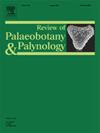A 1100-years paleovegetation and paleoclimate record from western Türkiye linked to the North Atlantic Oscillation variability
IF 1.7
3区 地球科学
Q2 PALEONTOLOGY
引用次数: 0
Abstract
The North Atlantic Oscillation (NAO) plays a significant role on atmospheric circulation variability in the North Atlantic region, modulating the strength and the direction of the westerly winds belt and storm tracks, affecting the precipitation patterns in the Eastern Mediterranean Region. Studies indicate significant variations in the mode of the NAO over the last millennium, largely driven by changes in solar forcing. Here, we present a palynological record from Lake Marmara, western Türkiye and a quantitative reconstruction of paleoclimate variables based on the variations of pollen taxa over the last 1100 years. The palynological records and paleoclimate reconstruction from Lake Marmara indicate that the Medieval Warm Period (MWP) was marked by low arboreal pollen (AP), high seasonality, and drier conditions, whereas the Little Ice Age (LIA) between ∼ 300–100 cal. yr BP was characterized by high AP, low seasonality, and wetter conditions. The results demonstrate a stronger alignment with the NAO variability over the past millennium compared to the other proxy records in Türkiye.
西部地区1100年的古植被和古气候记录与北大西洋涛动变率有关
北大西洋涛动(NAO)对北大西洋地区大气环流变率具有重要影响,它调节了西风带和风暴路径的强度和方向,影响了东地中海地区的降水模式。研究表明,在过去一千年中,NAO的模式发生了显著变化,这主要是由太阳强迫的变化所驱动的。在此基础上,我们对基耶西部马尔马拉湖的孢粉记录进行了分析,并基于近1100年来花粉分类群的变化对古气候变量进行了定量重建。马尔马拉湖孢粉记录和古气候重建表明,中世纪暖期(MWP)表现为低树花粉(AP)、高季节性和干燥条件,而小冰期(LIA)在~ 300-100 cal. yr BP之间表现为高树花粉(AP)、低季节性和湿润条件。结果表明,与t rkiye的其他代理记录相比,过去一千年的NAO变率与NAO的一致性更强。
本文章由计算机程序翻译,如有差异,请以英文原文为准。
求助全文
约1分钟内获得全文
求助全文
来源期刊
CiteScore
3.50
自引率
21.10%
发文量
149
审稿时长
6 months
期刊介绍:
The Review of Palaeobotany and Palynology is an international journal for articles in all fields of palaeobotany and palynology dealing with all groups, ranging from marine palynomorphs to higher land plants. Original contributions and comprehensive review papers should appeal to an international audience. Typical topics include but are not restricted to systematics, evolution, palaeobiology, palaeoecology, biostratigraphy, biochronology, palaeoclimatology, paleogeography, taphonomy, palaeoenvironmental reconstructions, vegetation history, and practical applications of palaeobotany and palynology, e.g. in coal and petroleum geology and archaeology. The journal especially encourages the publication of articles in which palaeobotany and palynology are applied for solving fundamental geological and biological problems as well as innovative and interdisciplinary approaches.

 求助内容:
求助内容: 应助结果提醒方式:
应助结果提醒方式:


